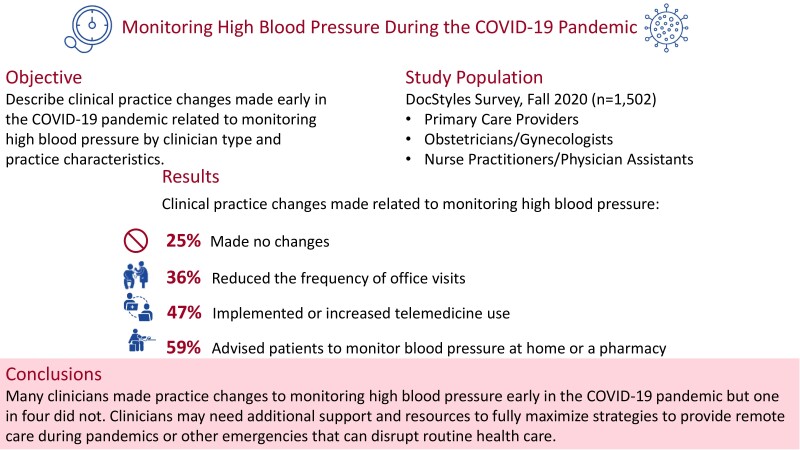Abstract
Background
Clinical practices can use telemedicine and other strategies (e.g., self-measured blood pressure [SMBP]) for remote monitoring of hypertension to promote control while decreasing risk of exposure to SARS-CoV-2, the virus that causes COVID-19.
Methods
The DocStyles survey collected data from primary care providers (PCPs), obstetricians-gynecologists (OB/GYNs), and nurse practitioners/physician assistants (NP/PAs) in fall 2020 (n=1,502). We investigated clinical practice changes for monitoring hypertension that were implemented early in the COVID-19 pandemic and examined differences by clinician and practice characteristics (p<0.05).
Results
Overall, 369 (24.6%) of clinicians reported their clinical practices made no changes in monitoring hypertension early in the pandemic, 884 (58.9%) advised patients to monitor blood pressure at home or a pharmacy, 699 (46.5%) implemented or increased use of telemedicine for blood pressure monitoring visits, and 545 (36.3%) reduced the frequency of office visits for blood pressure monitoring. Compared with NP/PAs, PCPs were more likely to advise SMBP monitoring (adjusted prevalence ratios (aPR) 1.28, 95% confidence intervals (CI) 1.11-1.47), implement or increase use of telemedicine (aPR 1.23, 95% CI 1.04-1.46) and reduce the frequency of office visits (aPR 1.37, 95% CI 1.11-1.70) for blood pressure monitoring, and less likely to report making no practice changes (aPR 0.63, 95% CI 0.51-0.77).
Conclusions
We noted variation in clinical practice changes by clinician type and practice characteristics. Clinical practices may need additional support and resources to fully maximize telemedicine and other strategies for remote monitoring of hypertension during pandemics and other emergencies that can disrupt routine health care.
Keywords: Hypertension, self-measured blood pressure, telemedicine, COVID-19, clinical practice



